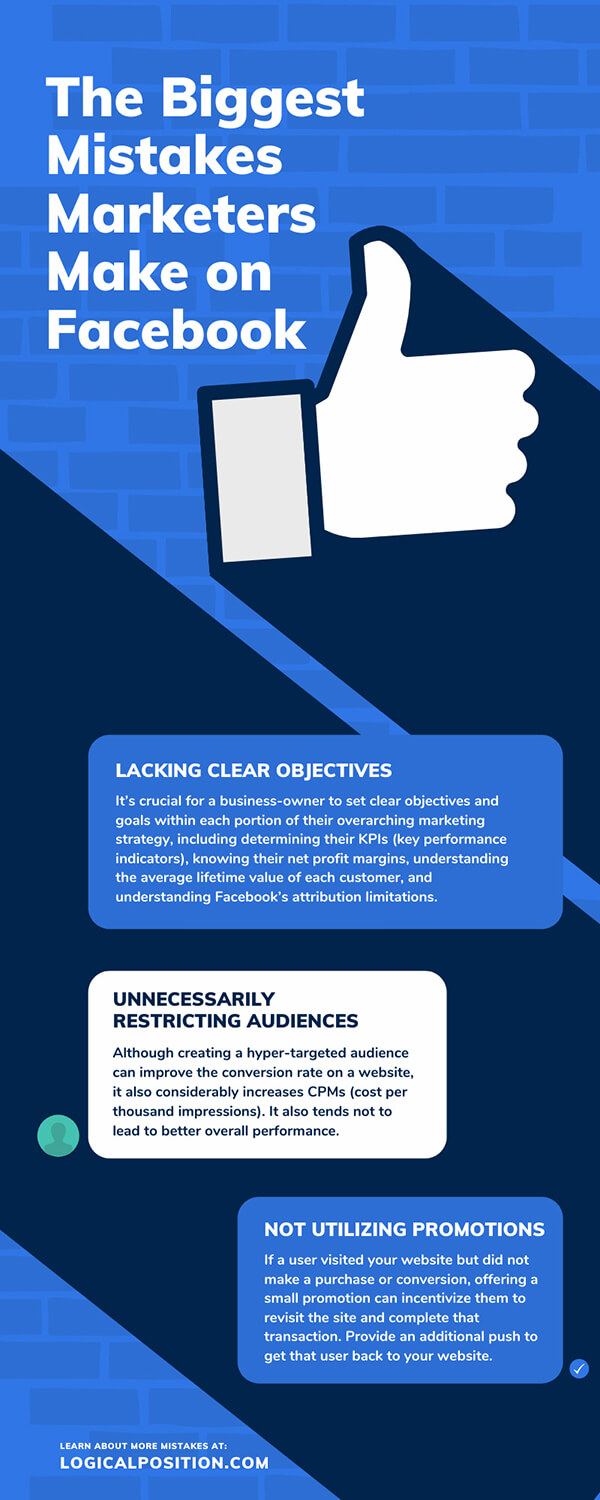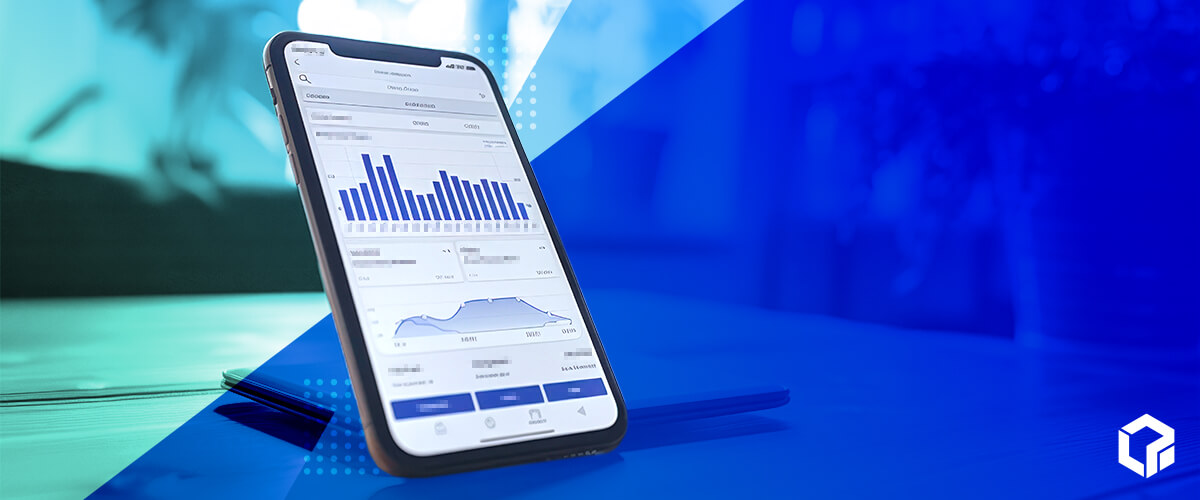Investing in paid social media advertising is an excellent idea for all kinds of businesses. However, many issues can arise when you set up your campaigns that may prevent you from reaching your full potential for success. For example, when a company sets out to advertise on Facebook, it may lack knowledge about or experience with the platform. Keeping up with the continuous changes on the platform is truly a full-time job. Check out the biggest mistakes marketers make on Facebook.
Why Facebook Is Beneficial
People spend time on social media platforms daily, so companies need to use this to their advantage to clearly communicate their unique value propositions to their target demographics. Facebook and Instagram campaigns are highly customizable, and they continue to add new features each month to provide improved experiences for both advertisers and users.
A large percentage of the population spends time on Facebook’s family of apps, which allows marketers to effectively remarket to users who had previously purchased from a brand or visited a website in the past. Users such as these are considered highly qualified potential customers, so finding a creative way to reengage them and get them back to your website is critical.
Facebook and Instagram allow companies to prospect new potential clients that don’t yet know about their brands. Much of marketing is providing solutions to problems people face. Marketing on Facebook allows marketers to serve highly targeted ads to educate potential customers about possible solutions. Facebook is a place of discovery for users, and it can help companies tell compelling narratives to drive new users to their websites.
Key Mistakes Marketers Make on Facebook
Lacking Clear Objectives
It’s crucial for a business-owner to set clear objectives and goals within each portion of their overarching marketing strategy, including determining their KPIs (key performance indicators), knowing their net profit margins, understanding the average lifetime value of each customer, and understanding Facebook’s attribution limitations. Business-owners can use this information to set realistic goals and determine which KPIs they should watch for in order to know when to increase ad spend on the platform. The goal should not be to have the highest ROAS (return on advertising spend) or the lowest cost per lead but to make as much profit through Facebook as possible.
Focusing on Vanity Metrics
Metrics such as page likes, comments on posts, and traffic to the website look impressive on paper, but they do not always lead to more conversions. Suppose a company’s main objective is generating more leads and website purchases. In that case, vanity metrics should work as indicators to watch and not as the main KPIs that the company focuses on.
Unnecessarily Restricting Audiences
One of the most prominent mistakes companies make with Facebook Ads is unnecessarily restricting their audiences. Although creating a hyper-targeted audience can improve the conversion rate on a website, it also considerably increases CPMs (cost per thousand impressions). It also tends not to lead to better overall performance.
Facebook has developed an outstanding machine learning platform for advertisers that does an exceptional job identifying who within an audience is most likely to convert. Don’t shy away from testing out broader audiences—especially if your Pixel has enough data built up for the algorithm to optimize.
Improperly Configuring Pixel
Improperly configuring your Pixel and ranking Pixel events is another considerable mistake that marketers tend to make when advertising on Facebook. The Pixel is the lifeblood of the ad account—configuring it properly is vital to finding success on the platform.
Complete each of these tasks before launching any campaign:
- Enable advanced matching.
- Verify your domain.
- Properly rank events in the Aggregated Event Measurement tool.
- Turn on the Value Optimization Toggle.
- Stay up to date with current tracking limitations on Facebook.
Once a company sets up its Pixel, it must utilize remarketing and Lookalike audiences to leverage the vast amount of data Facebook has to offer on its platform.
Creating Friction in the User Checkout Experience
Social media is a platform on which users are often not looking to make purchases. They spend their leisure time consuming content from their favorite content creators, friends, and family members. Therefore, companies must ensure that their buying processes are as seamless as possible. If a user decides to make a purchase from your social media advertisement, your checkout process must have no friction that could easily deter the conversion. Follow these tips:
- Add payment plug-ins.
- Prioritize fast load times.
- Utilize DPAs (dynamic product ads) to drive users directly to the product page.
- Make the conversion process as seamless as possible.
Not Utilizing Promotions
If a user visited your website but did not make a purchase or conversion, offering a small promotion can incentivize them to revisit the site and complete that transaction. Provide an additional push to get that user back to your website. Here are a few examples of promotions you can offer:
- Free shipping
- A small discount code
- Access to a special sale
Not Checking Audience Overlap
Not checking for audience overlap can cause issues for multiple reasons:
Lack of Targeting Clarity
Failing to check audience overlap can cause murkiness in the targeting options that are performing the best. Users with feet in different pools can convert, and Facebook will choose the most recent audience they were in to see the conversion. However, this audience isn’t always the one that had the most significant effect.
Increased Ad Fatigue
Ad creative fatigue can set in much more quickly for users when audiences overlap. If you serve ads to users from multiple ad sets or campaigns, the frequency numbers you see only correlate to that individual ad set or campaign. Fully understanding saturation across those levels can get difficult.
Making Large Decisions Based on Little Data
Making adjustments in the account too often can lead to your campaign getting stuck in a perpetual learning phase. Give your campaign time to get through the initial learning phase. Learning phases are typically active for about the first seven days of a campaign. Anytime you make a change, there’s an adverse effect. Ensure you look at enough data to make large-scale decisions, or you could be doing yourself a disservice.
Lacking Creative Type Diversity
Serving only one creative type limits your ad campaign. Many companies only serve the creative type that converts best, but this limits the conversions and puts a crutch on the data. Some people like videos, some people like DPAs—everyone has a preferred method of media consumption. Limiting campaigns to just one method removes the possibility of converting other people.
Failing To Monitor Ads Consistently
Not being vigilant about budget reallocation and feeding what’s working is one of the biggest mistakes marketers make on Facebook. You must continuously analyze campaigns and test your prior assumptions to find the most success.
It is important to evaluate audience sizes and current ad frequency when looking to increases budgets within individual campaigns or ad sets. Advertisers who see good returns within a specific ad set might push budget without realizing the frequency is high and the ad set is already saturated. This may still show an high ROAS (return on ad spend), but it will also leave a lot of ROAS on the table, which the company could capture if it scaled back and avoided oversaturating the market.
Relying Solely on Facebook for Marketing
Facebook is a great platform to get traffic to your website from social media, but using social media as a sole form of marketing is not sustainable. The best companies gain traffic from a diverse source of platforms. Invest in paid social media marketing services and other channels such as pay-per-click advertising on Google, search engine optimization, email marketing, and more.
For an expertly run Facebook advertising campaign, contact Logical Position today. We employ a team of top-quality people whose full-time jobs are to audit accounts, learn about the Facebook platform, research new features, and keep up with industry trends. Call us for a free consultation today.





